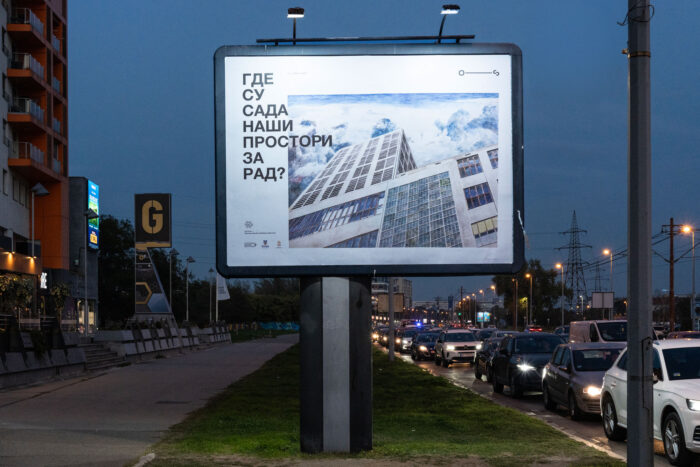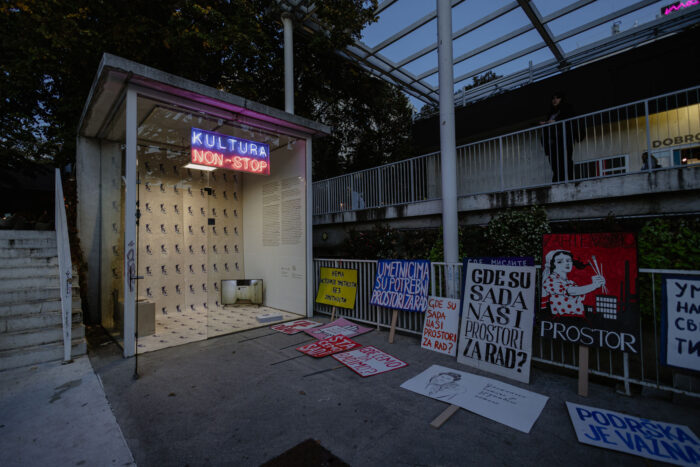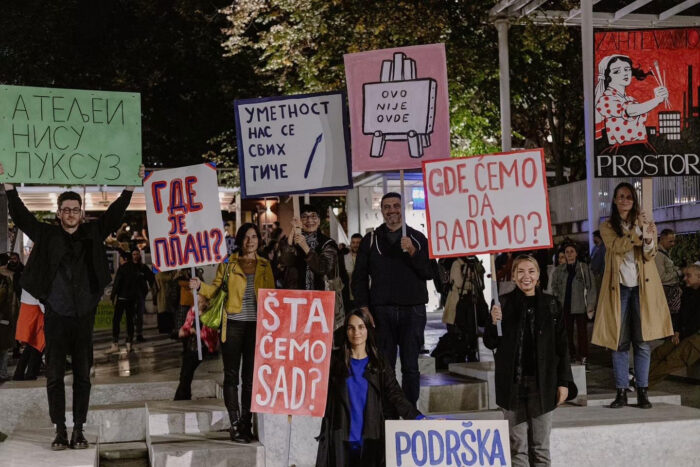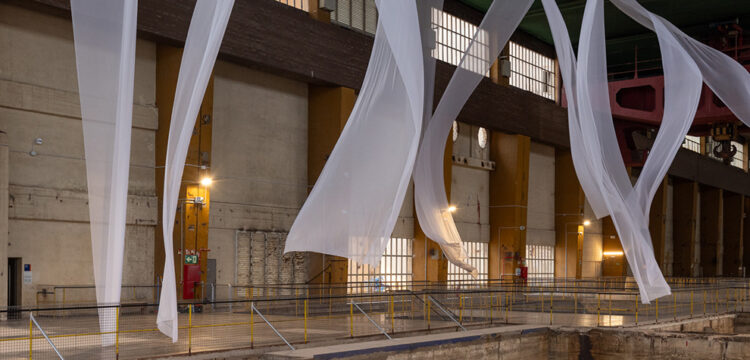Trace / траг
The Belgrado Salon and the “biennalization” of the art system
In recent years, we have often heard about a process—still ongoing—of “biennalization” of the art system. The steady proliferation of such events around the world seems to attest to the effectiveness, at least presumed, of this exhibition format inaugurated in Venice, now as far back as 1895, against the backdrop of the international expositions of the nineteenth century. In recent times, a number of publications have set out to question such reviews, tracing a still partially fragmentary history, in an effort to show their merits and flaws. Among the most obvious and, above all, shared criticalities of the internationally consolidated Biennales are the lack of interaction with local artistic communities and the frenetic and potentially damaging displacement of works, as well as the contribution made to the huge increase in so-called “hit-and-run” tourism or the need to submit to rules imposed by sponsors and institutions that are politically questionable at times and which, often and often, more or less directly condition the organization and artistic direction taken by these impressive exhibitions.
However, the denunciation of such issues more often than not does not seem to be reflected in action, merely observing both from the outside and from the inside the reiteration of these structural contradictions. But then, how to attempt to reverse course?

On the occasion of the 60th edition of the Belgrade Salon, the first and most important-although often unjustly forgotten by insiders-biennial in the Balkan area, Dobrila Denegri and Lorenzo Balbi attempted to answer this question with “Trace / траг,” a curatorial program moved by the intention of proposing a novel model for the Oktobarski Salon and perhaps, more generally, for all similar biennial events. The intent of the project, presented for one of the three sections of the exhibition, is to leave a “trace” that remains alive and operational even after the end of the official 60-day exhibition. It is an idea developed from the dialogue established by the two curators with the local cultural community and, especially, with younger artists. With “Trace / траг” Denegri and Balbi aim to address the lack of spaces dedicated to cultural production, as well as the resulting migration of Serbian artists and cultural workers.
The provocation, on which the project proposal is based, was to use the October Salon budget to purchase a space for the arts and make it available to the Belgrade community. A public place that could be a home for artists, but also a center for multidisciplinary production, a laboratory where skills and facilities could be shared in a collaborative, participatory and self-directed way.
Although it has not been possible to actually obtain a space in which to carry out this unusual curatorial proposal, “Trace / траг” has taken on the guise of a real awareness campaign, a “call to the arts” addressed to curators, thinkers, artists and professionals in the field, invited to propose and carry out actions, installations, performances, protests and occupations in the city, with the intention of shifting the attention of the international art system to the complex local situation.

Jacopo De Blasio: What does it mean or what should it mean for you to “leave a trace”? And what do you hope could be the legacy of your curatorial project also in reference to the format Biennial with which it has to relate?
Lorenzo Balbi: When I was invited to submit a proposal for the 60th edition of the October Salon—the oldest and most prestigious biennale in the Balkan area, active since 1960—I started with a provocation: to use the entire budget of the event to purchase and make available to the artists and community of Belgrade a space for the arts. A space that could be a home for artists but also a center for multidisciplinary production, a laboratory where sharing skills and facilities with a view to collaboration, participation and self-education. This proposal matured around my experience in Belgrade when I participated as a jury president in the 59th edition of the event together with Jan Chevalier, Alenka Gregorić, Siniša Ilić and Biljana Tomić. On that occasion, I had the opportunity to get in touch with the local artistic communities—especially of the latest generation—who strongly denounce a lack of spaces dedicated to them and the consequent compulsion to emigrate in order to continue pursuing their artistic careers; an issue to which is grafted the—very curious—situation whereby, despite its more than 60 year history, the October Salon has no exhibition space of its own. My thought also arose as a critical reflection on the format-Biennial in the post-pandemic era: what can an exhibition do today to prompt reflection on artists’ work, their future, their needs, and how to create a community? What do the great Biennales leave significant on the ground? Very often, when visiting major exhibitions, we ask ourselves this question, even more so in those places where a local art system struggles to take root and structure itself and artists have to struggle to have their professionalism and impact in society recognized. Once the Biennales are over, the works are usually removed, the international artists return to their countries, and the next edition is awaited, often helping to limit the funds available to local art communities. The project proposal started from the desire to create a new possible model in which a tangible “trace” would remain alive and operational even after the end of the traditional 60-day exhibition. These reflections, combined with my curatorial interest directed toward the redefinition of spaces as a means of creating community, were formalized in a proposal on which I invited Dobrila Denegri, a Belgrade-born curator and scholar, to collaborate.

The provocation, on which your project proposal is based, was to use the October Salon budget to buy an arts space and make it available to the Belgrade arts community. What were the impediments that hindered the concretization of your curatorial idea? How do you plan to pursue this in the near future?
Dobrila Denegri: In the shortlist, along with ours, came two other curatorial projects, and rather than choose one among the proposals, the October Salon board decided to promote all three projects. In this way, unfortunately, each curatorial group had to adjust to this new format, and consequently adjust to a reduced budget. At this point we decided to abandon the idea of buying a new space and focus our attention on the situation of the Jugošped space, which for us is symbolic and also paradigmatic. Jugošped is a large abandoned factory located in the area where the so-called Belgrade Waterfront—a massive Serbian government-sponsored construction project that is changing the urban face of Belgrade—is being built. About one hundred artists and creative people had occupied this factory, turning it into a living place, organizing concerts, small exhibitions, and different kinds of art programs. But most importantly, Jugošped had become a production space: artists and photographers had their studios, musicians had their rehearsal rooms, and craftsmen had built their workshops to work with many materials. So it was a crucial space to work, as well as a space that represented an entire community. Everyone knew that their presence there was temporary, but we thought they would have another year or two. Then suddenly the Ministry of Culture decided to take over that building and turn it into a new museum dedicated to Nicola Tesla, and now, after six months, everyone has been evicted. So our “new” project took on this question: where is in Belgrad the space for art and artists?
Jugošped is just one of the possible examples, as well as the most recent. The historic association of visual artists, ULUS, has also been struggling for a long time to keep their “home,” namely the Cvijeta Zuzorić Pavilion, while “Remont” one of the most important places for culture in the city has closed after 25 years, just these days. In a city where construction is frenzied, where old buildings are torn down to create space for new ones, and where every square meter is thought of only as commercial space, spaces for art and alternative forms of cultural production are disappearing.

What should a space designed for both the production and enjoyment of contemporary art look like from your perspective? Where institutions are absent, artists often adopt a DIY approach to make up for this lack, as well as to ward off possible pressure from above. What do you think are the merits and shortcomings of such an approach to artistic creation? And how could institutions establish a constructive dialogue with these self-financed and self-managed realities?
LB: The totally unprecedented situation that museums faced during the pandemic that disrupted established ways of living and working as well as the very possibility of enjoying art, made it essential to reflect on the nature of the public museum institution, its function, and its role for the cities and communities it serves. As MAMBo (Museo d’Arte Moderna di Bologna), we responded with a project that included a redefinition of the museum’s identity and strategy. The “Nuovo Forno del Pane” is an interdisciplinary production center that transforms the spaces and function of the “Sala delle Ciminiere” of MAMbo: no longer an exhibition space but a production space, a creative community in which art becomes bread for the mind and the museum is transformed into an oven, an incubator of creativity, a space that Bologna offers to its artists to restart, to be reborn after this planetary emergency. It has taken on a role of greater social responsibility in support of categories particularly affected by the pandemic-related crisis. In addition to hosting artist studios, it provides facilities open to various subjects. The museum reconfiguration proposed by this project is carried out by intensifying the principles of institutional cooperation and networking among institutions in the area, experimenting with the most radical museology, increasing scientific research and editorial production, but above all by reshaping the activity of mediation as the founding element of a new relationship with the public, based on “making” art with the direct involvement of artists, professionals and practitioners in an approach not exclusively based on works but also and above all on practices, process, relationship and the use of workshops and materials available. I think this can be a model of an institution transforming itself into a production space open to artists and communities.

The program of your section and, more generally, that of the Salon includes numerous workshops, laboratories, talks and lectures. In your opinion, should these kinds of events go beyond “simply” displaying the works on display? And in what way?
DD: Our curatorial concept aimed to issue the lack of spaces for art and artists in Belgrade. So, we did not want to take an exhibition space to have an exhibition in the conventional sense of the word. We wanted to open, create or temporarily occupy different public spaces. Our proposal takes the form of a campaign, including different formats: from billboards on the streets to artists’ protest on one of the city’s main squares. We also reopened one of the most legendary spots in the city: the club at the Academy of Fine Arts, so-called “hole” where people hung out from the 1980s until the early 2000s. Francesco Fonassi activated this place with “DREAM KLUB / Public Legal,” his FM and online radio project, creating an open space for music and speech. It can be heard on frequency at 98.2 MhZ and here.
We also involved Alessandra Saviotti with the “Arte Útil” project, initiated by Tania Bruguera. She, like Francis, knows Belgrade well, and like him, wanted to interact with the local art community. In collaboration with the “Ministry of Space” group of architects and urban planners, Saviotti organized public debates and workshops with students and young artists. It’s a call to change conditions and social order through art, and what it creates are the tools, concrete and symbolic, to make oneself more culturally aware and active. So these are forms of self-organization for artists, forms of activism for citizens, and other similar forms of cultural engagement.

By what criteria did you select the artists to be involved in your project?
DD: We discussed a lot and shared all the choices. We reasoned about artists who have already problematized the theme of space understood as a tangible place dedicated to the creation and dissemination of art. For example, we invited Alfredo Jaar because he has been asking the question about the value and weight of culture for years, starting from the Beuysian equation “Kunst = Kapital,” which he now translates into “Culture = Capital.” Moreover, Jaar, who by training is an architect, built the first paper museum in a small town in Sweden called Skoghall, where there was nothing but the factory specializing in tetrapak production. But after giving the community their first museum, he made an even more dramatic and striking gesture: he burned down the kunsthalle. After that gesture, the community decided to raise funds to commission the construction of a permanent kunsthalle. Jaar narrated this and his other projects related to the themes of civil solidarity, migration, and current political events in a performative lecture, which is more than the usual “artist talks.”
LB: Maria Eichhorn was one of the first artists I thought of when our project changed from a “potential action” (the purchase of a space in Belgrade) to an “awareness campaign.” In particular, I thought of her work “Kτίριο ως περιουσία άνευ ιδιοκτήτη /Building as Unowned Property” produced by Documenta on the occasion of the 14th edition in Athens curated by Adam Szymczyk. The work consisted of the purchase of a building in Athens, which would then be given the legal status of unrecognized property so as to obtain forever a free place in which to reflect on the nature of public spaces, the need to resist gentrification processes, and how art can have urban and structural impacts in the urban and social fabric of a city. It is evident how this work had a fundamental influence on my proposal and therefore the project could not be separated from the invitation to Belgrade by Maria Eichhorn, who decided to participate in the exhibition precisely with a workshop that will start from the analysis of the Athens work and the publication related to it. Any self-respecting campaign in public space, however, needs direct interventions in the urban fabric, and that is why I also thought of inviting Aldo Giannotti, an Italian artist who lives in Vienna and with whom I have had the opportunity to collaborate on several occasions in the past. His works often take the form of wall interventions, billboards or writings in which, through the use of drawing, the artist induces the audience to reflect on themes of contemporaneity, shared living and constructive collaboration. In particular, I thought of him in relation to one work, “Italian Square,” first presented in 2014 in Vienna. Is a square platform set up in the exhibition space to commemorate the Roman forum. It is a square, a space that represents a place for gathering, discussion and public representation. Through an awareness campaign, the artist invites Italians living in Vienna to get on the platform. This forum, therefore, functions as a cultural stereotype of Italian urban architecture. And on the occasions when it is realized and materializes in the exhibition space of another country, it reverses the roles of natives and foreigners, creating a new community of reference. Lucy & Jorge Orta will also insist on these issues as they seek to seat the Belgrade art and political community at the same dining table.

Does the decision to start the program of the event with one of the large tables set by Lucy + Jorge Orta represent an opportunity for confrontation, however convivial, between the Belgrade art community and the local government?
DD: Initially we wanted to organize this collective performance right in front of the “Jugošped,” which is nestled in a site totally destroyed by bulldozers and stands there like a relic of the past. We wanted to give visibility to the local art community and we also wanted to try to invite the authorities, who set up their own political narrative of a prosperous new Serbia, with GDP growth of more than 3 percent, right from this project called “Belgrade Waterfront” and others like it. So create a time when the parties could be found “breaking bread” and sharing a meal, as if it were a form of peaceful protest, but also an invitation to dialogue. In the end we decided to move the protest site in front of the Belgrade Cultural Center, which is the organizing body of the October Fair, and which is located in a pedestrian zone, right in the center of the city. The lunch involved 200 people, sponsored by the “Flowers of Evil” restaurant and the “Šarlo” bakery, because we did not want money from the exhibition budget to be spent on lunch. Everything was designed by Lucy and Jorge: the tablecloths, the runners, but especially the themes of the discussion were decided by them in collaboration with the artists of “Jugošped” and the curators of the Belgrade Cultural Center. Four macro themes had to be discussed: POLICY, CULTURAL STRATEGY, ARTIST PRACTICES and RESILIENCE. In this last section was the question, “Is it possible to imagine a life fully dedicated to art faced with the social disdain and devaluation of the artist?” Here, themes like these were being proposed, indeed they were being pulled out of the loaves of bread.

In the past, movements such as the Art Workers Coalition and individual initiatives such as Gustav Metzger’s Years Without Art have led to the temporary cessation of art production to show dissent from the art system. In your opinion, in this day and age, can the art strike still be an effective form of protest? And how, in your opinion, can art become a means of protest?
DD: Metzger was very radical but also very lonely in his “calls to arms.” His protest was internal to the art system and against the market taking over. Even we here have realized that it is really difficult to counter, or rather, to impose ourselves against the general vacuum. But what the artists have addressed is not related to the problems of the system, as the system itself almost does not exist, or exists in a different and distant form from what we know in the global North. The protest of artists in Belgrade that we wanted to support is anchored in essential needs: the need for a space to work in and the possibility of renting it at reduced prices, since no artist can sustain those appropriate to the housing market. Nemanja Nikolić, Nina Ivanović, Lidija Delić, and Marija Šević are artists we invited as representatives of the “Jugošped” community, and they have tried to transpose their campaign and protest into a performative form, working as artists, producing works, as well as the tools (posters, transparencies, etc.) to make the manifestation realized in the public space more visible.
LB: I am convinced that our exhibition, thanks to the work of the artists we have invited, will be able to leave an important trace in the artistic and social fabric of Belgrade; perhaps it will not have permanent traces like the ones we had originally envisioned, but allowing ourselves a space for reflection and confrontation in contemporary turbo-capitalist society is perhaps even more important than leaving permanent visual memories. Perhaps our project has shifted from a proposal on physical space to a proposal on space/time, which is now considered the most important of riches. We can think that the exhibition space of “Trace” is in the minds of all those who are and will be involved in the shared reflections that this project will solicit, in the thoughts and ideas that will arise from it.





